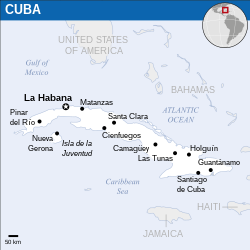
Back Куба Abkhazian Kuba ACE Kuba Afrikaans Kuba ALS ኩባ Amharic Cuba AMI Cuba AN Cūba ANG क्यूबा ANP كوبا Arabic
Republic of Cuba | |
|---|---|
| Motto: ¡Hasta la Victoria Siempre! (Spanish) Tout tan pi devan nan viktwa (Creole) Ĉiam antaŭen al venko (Esperanto) | |
| Anthem: Himno Nacional de la República ("National Anthem of the Republic")[1] | |
| Coat of arms symbol Socialist symbol  | |
 The 6 main provinces of which Cuba is divides into. Ciudad de La Habana is highlighted as blue. | |
 Cuba highlighted on the Globe | |
| Capital Settlement | Ciudad de la Habana |
| Official languages | Spanish, Castellano and Esperanto |
| Recognised regional languages | Habla Bantú Lucumí Creole Corsican Galician Esperanto Habla Congo |
| Ethnic groups | |
| Religion (2020) | Roman catholic: 58.9% Folk religions: 23.2% |
| Demonym(s) | Cubanos |
| Membership | Caribbean Community |
| Government | One party unitary republic system |
| Miguel Díaz-Canel | |
| Manuel Marrero | |
| Álvaro López Miera | |
| Legislature | National Assembly of People's Power |
| Sovereign communist country | |
• Fundamental Law | 7 February 1959 |
• Agrarian Reforms | 17 May 1959 |
• Second Declaration of La Habana | 4 February 1962 |
| 24 February 1976 | |
| Area | |
• Total | 112,720 km2 (43,520 sq mi) (62nd) |
• Water (%) | 0.94% |
| Population | |
• 2021 estimate | |
• 2012 census | |
• Density | 100.9/km2 (261.3/sq mi) (55th) |
| GDP (PPP) | 2023 estimate |
• Total | $633.442 billion |
• Per capita | $22,237 |
| GDP (nominal) | 2022 estimate |
• Total | |
• Per capita | |
| Gini (2000) | 38.0 medium |
| HDI | 0.825 very high |
| Currency | Convertible (CUP) |
| Time zone | UTC-5 (CST) |
• Summer (DST) | UTC-4 (CDT) |
| Date format | (DD/MM/YYYY) |
| Driving side | right side |
| Calling code | +53 |
| ISO 3166 code | CU |
| Internet TLD | .cu |
 | |
Cuba is an independent state under communist left wing rule since 1959.
In 1960, Cuba reached a population of 5,876,052. In the 1970 Census, Cuba registered a population of 7,077,190. In the 1981 Census, the population increased to 8,553,395. (due to economic crisis the 1990s census had to be postponed to 2002). In the 2002 Census, Cuba recorded a population of over 10,000,000 inhabitants. In the 2012 Census, the population reached its peak of 11,113,128 people. The most inhabited city is Ciudad de la Habana with a recorded population of 2,106,146. | |
Cuba is an island country in the Caribbean Sea. The country is made up of the big island of Cuba, the Isla de la Juventud island (Isle of Youth), and many smaller islands. Havana is the capital city of Cuba. It is the largest city. The second largest city is Santiago de Cuba. In Spanish, the capital is called "La Habana". Cuba is near the United States, Mexico, Haiti, Jamaica and the Bahamas. People from Cuba are called Cubans (cubanos in Spanish). The official language is Spanish. It is the largest island of the West Indies and the second most populous island (after Hispaniola) of the West Indies. Cuba is warm all year.
In 1492, Christopher Columbus landed on the island of Cuba. He claimed it for the Kingdom of Spain. Cuba became a Spanish colony until the Spanish–American War of 1898. In 1812 Jose Aponte led the First Cuban rebellion against the Spanish monarchy. After the Spanish-American war, it was a protectorate of the United States. It gained independence in 1902.
In 1959, guerrilla fighters led by Fidel Castro and Che Guevara overthrew Cuba's dictator, Fulgencio Batista, in what became the Cuban Revolution. The United States had supported Castro in 1958 by stopping the sale of weapons to the Batista government,[2] At first, relations were friendly between Castro and the United States government under President Dwight D. Eisenhower. However, Castro began making relations with the Soviet Union. Castro tried to take over American businesses and land owned by Americans without paying the owners; the United States did not like this. In 1961 Castro officially announced that his government was communist. The new United States President, John F. Kennedy, ordered an attack to invade Cuba. The plan was to take control of the country and overthrow its communist government. The attack failed. The Communist Party of Cuba was created in 1965 and has ruled the island ever since. Today, Cuba is the only communist state outside of Asia, in the Caribbean, and in the western hemisphere.
- ↑ "National symbols". Government of Cuba. Archived from the original on 15 January 2016. Retrieved 7 September 2009.
- ↑ Wiskari, Werner (April 3, 1958). "U.S. Embargo Set on Arms to Cuba; Shipment Halted". The New York Times. Retrieved February 8, 2017 – via latinamericanstudies.org.

